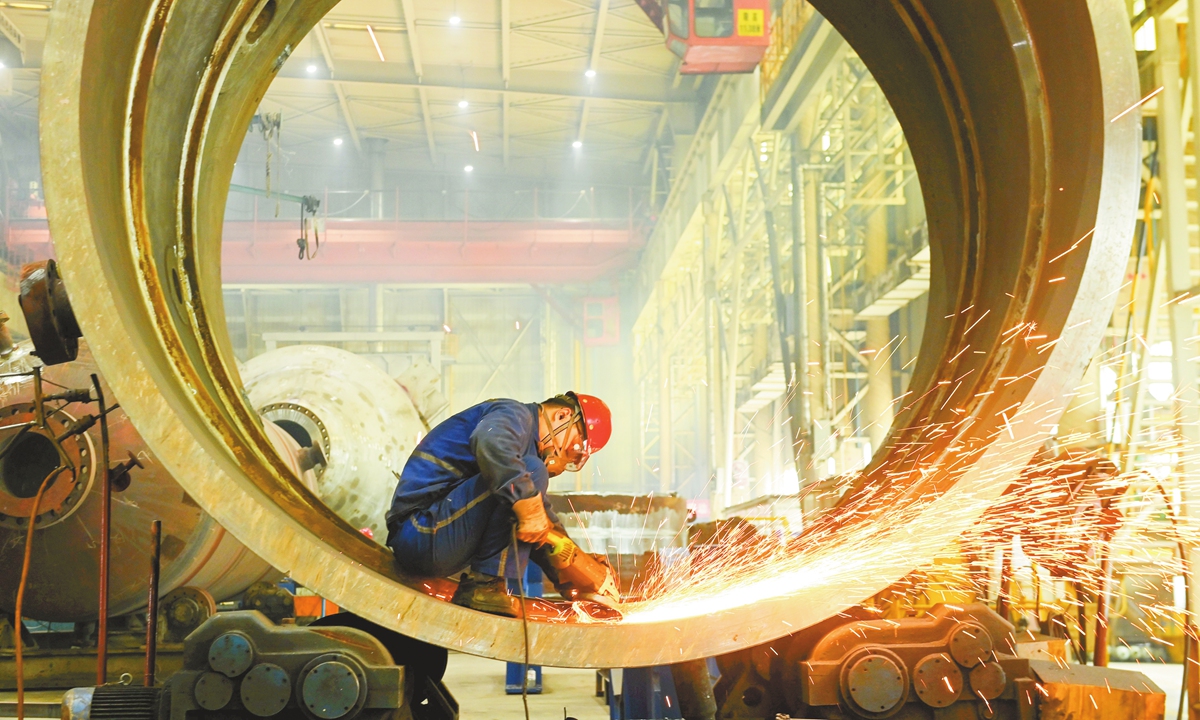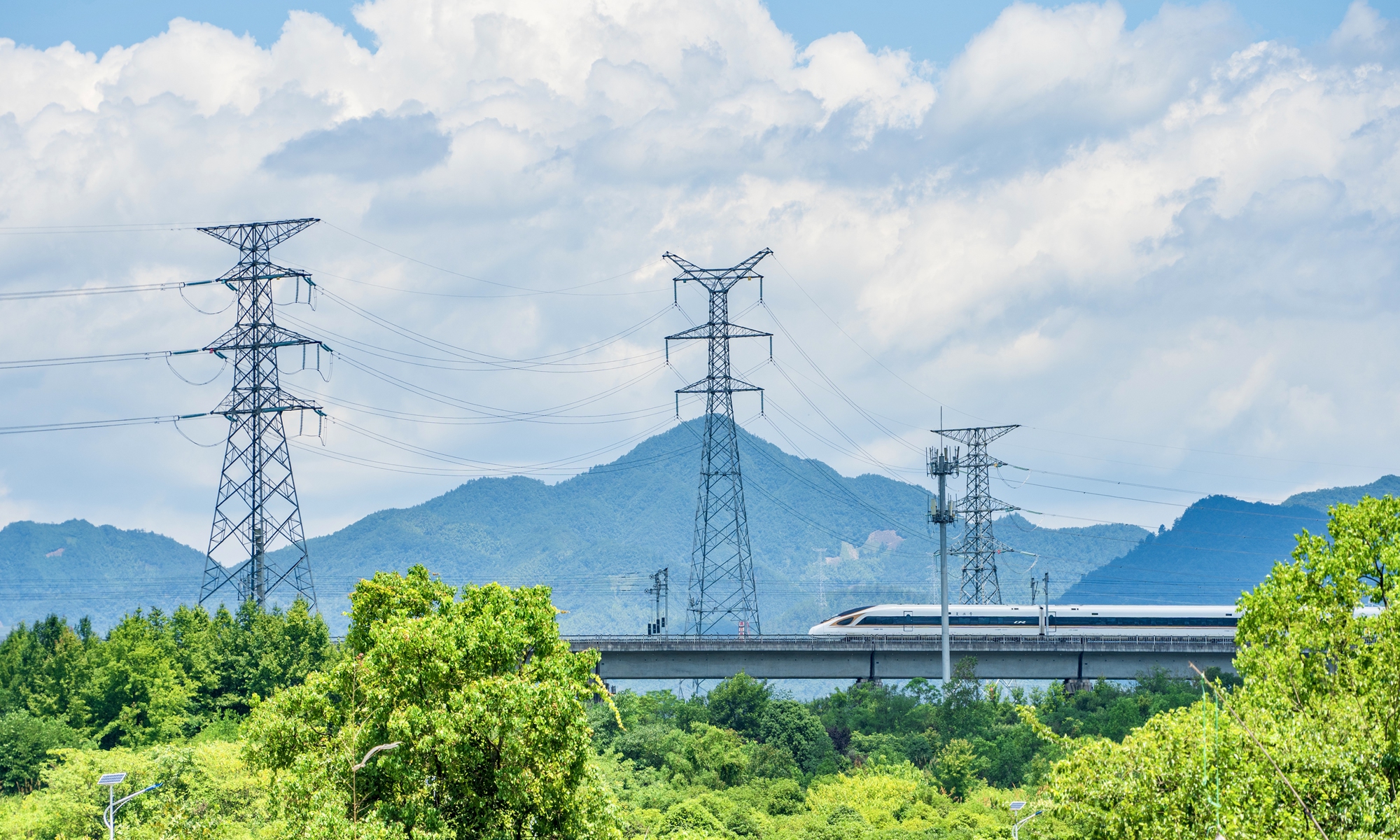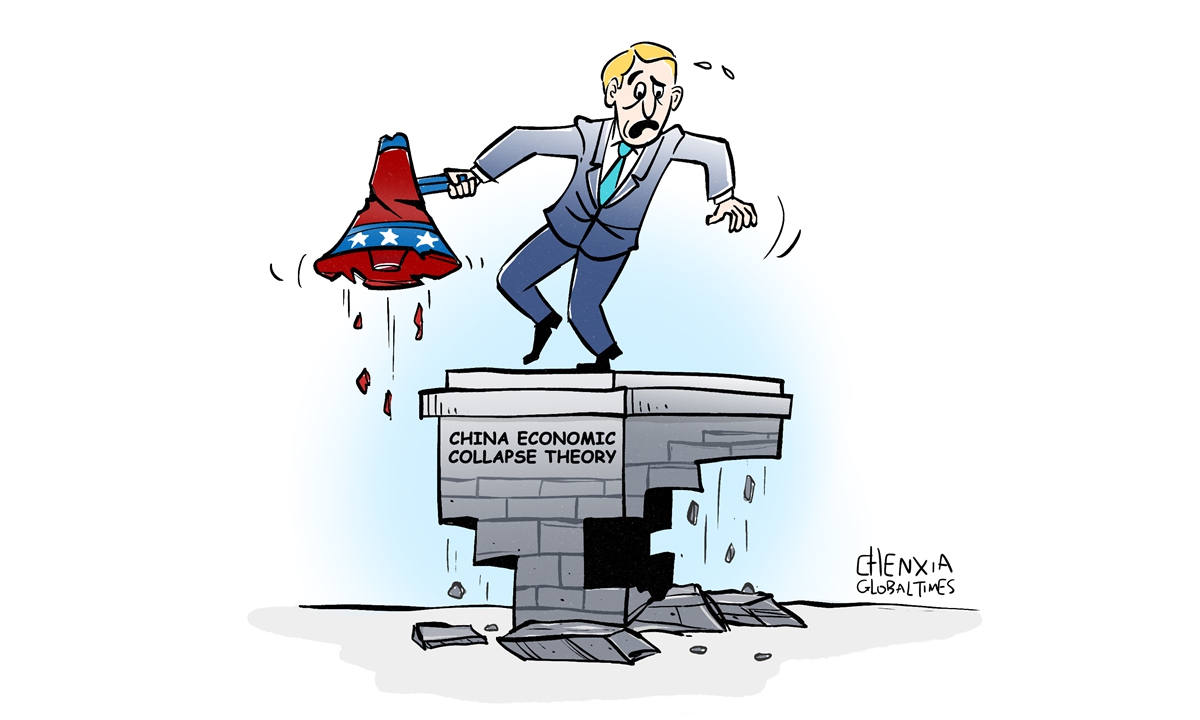Confidence is strengthening in achieving annual economic target of around 5 percent
Lead with Action, Fortify with Unity

A construction worker builds petrochemical equipment at a factory in Qingdao, East China's Shandong Province on October 31, 2024. Photo: VCG
Now China has entered November.
Noting that the year 2024 will end in less than two months, Chinese President Xi Jinping stressed the need to push forward with various work, especially the economic work, in an effective and solid manner, so as to deliver on the economic and social development goals for the whole year.
The remarks were made during his inspection tour to Central China's Hubei Province from November 4 to 6.
Xi has also stressed all-out efforts to strive to achieve the annual economic and social development goals multiple times since a meeting of the Political Bureau of the Communist Party of China (CPC) Central Committee on September 26, in his recent inspection tours to East China's Fujian and Anhui provinces, as well as at the study session for senior provincial and ministerial-level officials.
How's the current situation?
"The confidence in achieving the annual economic goal of around 5 percent is strengthening," Chinese officials from the National Bureau of Statistic (NBS) made the judgment at a press briefing in mid-October to release the third-quarter GDP data.
The confidence stems from a set of recently released economic data, which points to the economy's stabilizing fundamentals and recovery in business activities.
In October, China's manufacturing Purchasing Managers' Index (PMI) rose to 50.1, marking a return to the expansion territory, setting off a good opening for the fourth-quarter economy.
Though the GDP growth rate in year-on-year term was 4.6 percent in the third quarter, slowing down from the 4.7 percent recorded in the second quarter and 5.3 percent in the first quarter, in terms of quarter-on-quarter basis, China's economy grew 0.9 percent in the third quarter, maintaining positive expansion for nine consecutive quarters.
Sheng Laiyun, deputy head of the NBS, said that the 4.8-percent growth rate in the first three quarters came as a hard-won result, and lays a solid foundation for achieving the annual economic goal.
A number of foreign institutions have raised their forecasts for Chinese economy after the NBS released third-quarter GDP data. For example, Goldman Sachs, in a research note in October, revised China's 2024 GDP forecast from 4.7 percent to 4.9 percent. Zhu Haibin, chief China economist at JP Morgan, also noted that China's economic growth dynamics has showed a moderate rebound by the end of the third quarter, with domestic activity indicators in September generally beating market expectations.
Overall, "stability" and "progress" remain the main themes of the Chinese economy. On one hand, the foundation underpinning China's stable economic growth is solidifying now, as four major macroeconomic indexes - growth, employment, inflation, and the balance of international payments - indicate that the economy is generally stable with steady progress, and provide a solid foundation for China's macro economy to maintain resilient growth, Chinese economists said.
On the other hand, the dynamics for economic progress are strengthening, as exemplified by investment in high-tech industries and high-tech manufacturing industries, where the growth rate of value-added significantly outpaced the overall level. The more an industry is characterized by high technology, high efficiency, and high quality, the more favorable its development trend.
Confidence from reform
The third-quarter GDP report also highlighted efforts in economic system reform. And a bunch of measures have been carried out in recent months to benefit livelihoods, boost consumption and stabilize the housing market.
At the end of October, China has implemented a financial policy that benefits 150 million residents and reduces existing housing mortgage payments by 150 billion yuan ($20.73 billion) a year. Simultaneously, the People's Bank of China, the country's central bank, also reformed and improved a mechanism that allows borrowers to negotiate with banks independently and adjust housing mortgage rates dynamically.
Chinese policymakers also introduced a package of incremental policies since late September, which bears both immediate results and long-term ramifications. Dong Yu, executive vice dean of the China Institute for Development Planning at Tsinghua University, compared the measures to "a milestone move in macroeconomic adjustments."

The 7th China International Import Expo takes place at the National Exhibition and Convention Center in Shanghai on November 8, 2024. Photo: VCG
The stock policies and incremental policies include not only counter-cyclical measures for macroeconomic adjustment, but also those aimed at deepening reforms to improve the quality of medium- and long-term development. As such, these policies will drive the building of a high-level socialist market economy and help advance Chinese modernization.As China further advances comprehensive deepening of reforms, it is important to note that economic system reform could be the "key leverage point" that has the effect of "pulling one hair and the whole body is affected."
In the system reform of economic fields, China is accelerating the implementation of major national strategies and the development of security capabilities in key areas, while supporting large-scale equipment upgrades and trade-in policies for consumer goods with robust measures. Meanwhile, the legislative process for law on private sector promotion is underway, and the opening-up of the capital market is further gaining steam.
It is palpable that China has been adhering to the unity of reform and the rule of law, the dialectical unity of abolishing the old and establishing the new, as well as coordinating the process of reform and opening-up, so as to make the combined effect of "policy boost" and "reform gaining momentum" strong and effective.
The series of reform efforts are also injecting new impetus into China's development. And it is believed that the solid reform results will make the country more capable of achieving its annual economic and social development goals.
The rapid growth of Futian district in Shenzhen, South China's Guangdong Province offers a vivid example in this regard.
The district is one of the earliest developed districts in Shenzhen. In its early stage of development, Futian faced problems such as limited space and rising costs. However, it overcame those bottlenecks by focusing on developing new quality productive forces, and such reform has spurred the growth of new economy. In the past three years, the number of "little giants" in the district has increased by more than eight times, and the district's GDP per unit area now is over four times the Shenzhen average. In October, Apple's application research lab, with an investment exceeding 1 billion yuan, was completed and began operations in Futian.
According to a communique of the Third Plenary Session of the 20th Central Committee of CPC, China will improve the institutions and mechanisms for fostering new quality productive forces in line with local conditions. It is expected that the implementation of a package of incremental policies will accelerate the expansion of new quality productive forces.
There are plenty of rooms for China to develop new quality productive forces, especially taking into account the country's technological innovation and an ultra-large market with the greatest growth potential.
On November 5, the first day of the China International Import Expo, purchaser Shanghai Nuoyin Electromechanical Technology Co signed the first purchase contract of the expo worth $50 million. The contract covers such areas as semiconductors and automotives, once again highlighting the allure of China's market with sheer size.
Chinese officials have indicated that in addition to the current measures, they're also studying and preparing new incremental policies. "As the effects of these policies continue to materialize, the economy for the year will show a trajectory of high growth early on, moderate growth in the middle, and an upward trend toward the end," said Huang Hanquan, director of the China Academy of Macroeconomic Research.
Confidence from firms
In September, China's value-added industrial output rebounded for the first time after four consecutive months of decline. In October, both the year-on-year and month-on-month sales of commercial housing achieved growth, showing a positive trend of stabilization in the property market after a period of decline.
Those sets of data underscored the overall stepped-up expansion of production and business activity, with more positive factors accumulating.
From the perspective of enterprises, more Chinese companies have been witnessing a jump in orders. For example, a batch of intelligent, flexible production lines has just been put into operation at the production base of Shenzhen JLC Technology Group Co in Zhuhai, South China's Guangdong Province. Liang Dongbing, the head of the base, said that the rapid development of artificial intelligence has brought in a large number of orders, and putting the new production lines into service will ensure reliable product delivery.
Likewise, foreign enterprises have also been scaling up investment in the Chinese market. Germany-based Mercedes-Benz Group recently announced plans to jointly invest over 14 billion yuan in China with its Chinese partners. Analysts said that the increase in investment by German companies shows their long-term confidence in the Chinese economy.

A high-speed train departs from Huangshan North Railway Station in Huangshan, East China's Anhui Province on July 5, 2024. Photo: VCG
As the market economy also equates to an economy of expectations and confidence, it is believed that the economy will gain momentum when businesses are confident. With supportive policies in place, more and more companies are accelerating their transformation, which is set to further unleash growth potential.Chinese officials have stressed that "confidence in achieving the annual economic goal of around 5 percent is strengthening." But confidence doesn't come from the sky. It is nurtured through hard work, grows through striving, and rises through resilience. What should we do to boost confidence? As the saying goes: Prioritize action and stand as one.
The article was originally published on the front page of the People's Daily on November 12, 2024

GT



